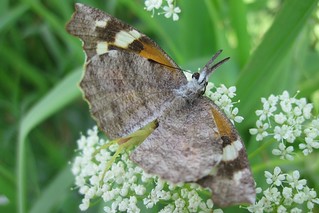While conducting a survey of bumblebees in East Montpelier
last week, on the hottest day of the year (so far), I found myself walking
along a seemingly ordinary roadside, scanning the flowers as I went. Bumblebees seemed sparse in this location, so
as my eyes passed over the hundreds of blossoms of purple and pink, my
attention was drawn to other creatures.
A pair of Monarchs danced together near a patch of milkweed, and Tiger
Swallowtails floated on the distant breeze, but one butterfly in particular seemed
to stick out.
A pair of wings, orange and black, were splayed out awkwardly
across the top of a flower. I hopped off
the road and into the brush to get a closer look, with my net clenched in my
hands ready to be swung. But the
butterfly didn’t budge. As I approached closely,
within reaching distance, I noticed something was different. This butterfly wasn’t about to fly away,
because its abdomen was clenched in the jaws of a crab spider!
Over 100 species of crab spiders can be found in the US. Unlike many of the most familiar spiders,
which build webs to catch their food, crab spiders rely on stealth to ambush
their prey. Some crab spiders have
discovered, through the millennia, that
if they can blend into a location that is visited frequently by other insects, they
can simply wait for a meal to land right in front of them.
The Goldenrod Crab Spider (Misumena vatia) is common in Vermont, and can be found sitting atop
flowers, waiting for an unsuspecting insect to be lured by the sweet nectar
underfoot. The butterfly I found had
fallen victim to a vatia. I was in disbelief to find that its latest
catch was an American Snout (Libytheana carinenta),
an exceptionally rare butterfly in Vermont and a first for Washington
County.
American Snouts have earned their name because they have a large
nose-like protuberance that extends from the front of their head, and is
thought to be an adaptation to mimic the petiole of a leaf and aide with camouflage. In the southern part of their range, Snouts
can be very common. During some years, populations
in the southwest can explode, causing swarms that are said to “darken the sky
and halt traffic.” But on the northern periphery
of its range, the Snout can be quite rare, and had never been documented in
Vermont before 2002.
As with other winged creatures, butterflies can stray extremely
far from where they would be expected to be seen. Some wander hundreds of miles from their typical
haunts and are discovered in unexpected places.
Who knows where this Snout could have ended up, had its journey not been
ended by a crab spider in East Montpelier.
And who knows how many other Snouts are flying around in Vermont, just
waiting to be discovered.




Great story! How many millions of these sorts of exciting adventures occur every day!!
ReplyDelete